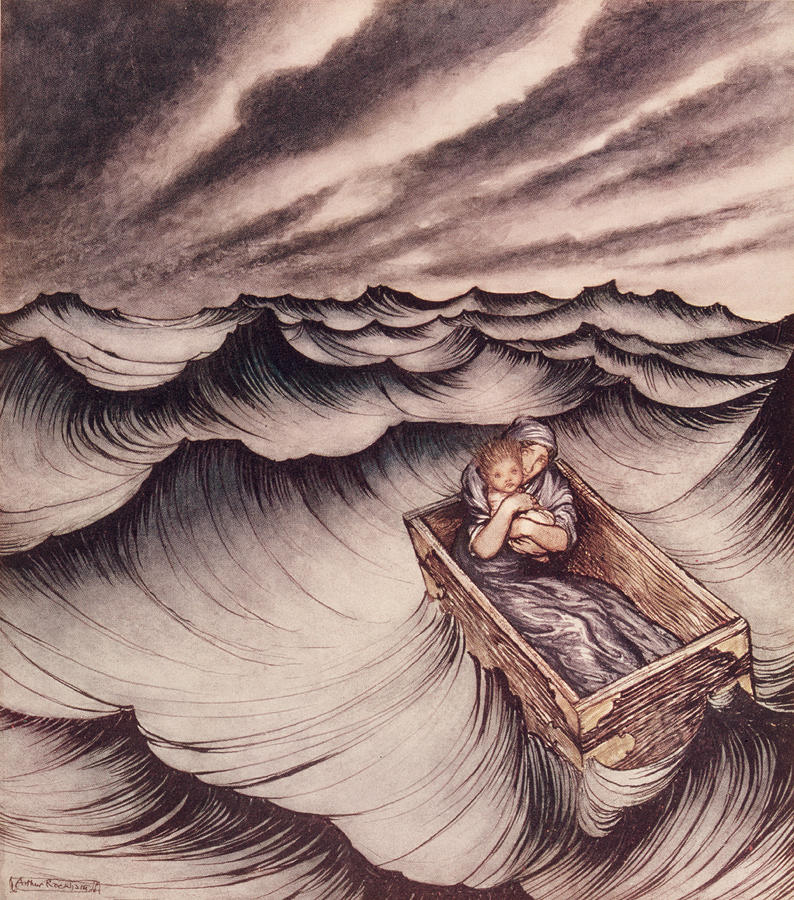Death, right? Pretty cut and dried case of attempted murder. But instead they get put in a rudderless boat and cast out to sea. The second time we see this concept, it's in Chaucer's Man of Law's Tale. The lovely, luckless lady Custance is put out to sea in a boat twice, and both times she just floats around, frightened and passive.
However, the Lord takes care of her, while Albina and her sisters, interestingly, strike a deal with Satan instead. In fact, calling them 'helpless' was not quite right: they survived for a long time on the sea, and Monmouth doesn't mention that the Lord ever spared them a second glance. They must have learned to work with the ocean on their travels, just as they later learn to thrive in Albion, despite the fact that it's wilderness. Why these two different women-on-water tales? Why do these women end up where they end up? Why place these women in the sea?
The ocean itself is often associated with femininity. The Mesopotamian myth Gilgamesh relates that the ocean came from the goddess Tiamat, and in Greek mythology, the goddess Aphrodite (or Venus in Roman mythology) emerged from the sea.
It's also interesting to note that the women-cast-out-to-sea story line didn't originate in medieval times. Greek myth relates the story of Danae, the mother of Perseus, whose father was told that her son (begotten by Zeus- who else?) would kill him. So, doing the logical thing, he put her in a wooden chest and cast her out to sea.
Danae was helpless, but Zeus guided the chest into the net of a kindly fisherman.
So why are women who "transgress" (intentionally or not) cast out in the ocean? In the case of Custance (who transgressed by marrying a converted Christian) and Danae (who was the instrument of her father's doom), they are isolated and dependent on outside forces to keep them safe. However, Albina and her sisters keep themselves alive with no apparent divine help. They must be utilizing the ocean. And yet, Custance and Danae are depicted as pure and righteous because they depend on a force independent of the ocean. Could the ocean be seen as a dangerous thing for women to engage with? An unknown feminine force?
It's peculiar that capable, strong female behavior is attributed to evil Satan-doinking murderesses, while 'moral' female behavior depends on the protection of the Lord. The sea and these two tales about it may represent medieval anxieties about womanhood and female power. It seems that according to the Man of Law's Tale, the only acceptable form of womanhood would be to be passive and frightened and waiting when wandering the ocean, while mastering it or exploring it represents a danger to the role of females in Medieval English society.





There was a lot of really compelling and interesting information in this post. It is interesting to me that the ocean is often believed to be filled with so many feminine lifeforms, such as mermaids or sirens. The ocean is often seen as dangerous, uncontrollable, unpredictable and filled with the unknown. This seems to reflect many of the anxieties that men seemed to have about women. There were many aspects of women, such as their periods, that were unknown and uncontrollable to men and led to the idea that women were dirty and dangerous. I can definitely see a correlation between the ocean and women and it seems to make sense that the women who were cast out upon the ocean (Custance, Albina, etc) would be spared.
ReplyDeleteEmma, the part in your post about there being so many women in the sea got me thinking: Why were women depicted so often in the sea? I think this presence might suggest the actual lack of women at sea -- or at least ones that would fulfill the fantastical roles they played in writing. That they were written in to adventurous tales is interesting because usually those who are absent or ignored in history don't become a part of it. But because of Medieval men and their desire to shape women, we end up with characters like Custance and Albina. Despite their exaggerated holiness or evilness, they represented everything that men were anxious about at that time. This could mean that women weren't as passive as men would have liked them to be.
ReplyDelete